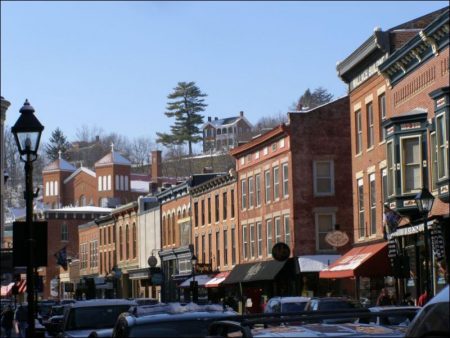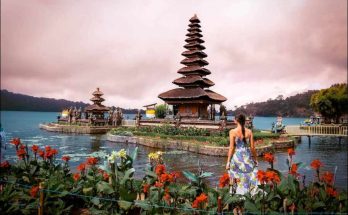Galena (603 alt., 3,460 pop.), in the extreme northwest corner of the State, perches on the terraces cut by the old Fever River, a novel sight to eyes accustomed to the prairie flatness. Its streets climb tortuously from level to level of the ancient river bed, and the houses cling to the hills like chalets in an Alpine village. Deserted warehouses and granaries line the old course of the river.
On the middle slopes the church spires rise above masses of trees along winding cobbled roads; many steep flights of steps climb the bluffs; on the heights is the high school, the clock of which marks the time for the countryside. Typical of the long flights of steps that scale the bluffs are those between Main and Prospect Streets, leading to the high school. In the valley trickles the stream, now called the Galena River, which cut the terraces on which the city is built; its once strong current bore to Galena’s wharves the freight of the northwest, but Galena is now the ghost of a metropolis, the relic of the first major industrial development of the region.
The most vivid reminder of Galena’s past is its architecture. The diversity of background of Illinois’ pioneers brought about the great variety of styles in which they designed their houses and public buildings. Because of this diversity, Illinois has never developed a style distinctively its own, as have most of the eastern seaboard states. But in Galena survive more examples of good American building than perhaps anywhere else in Illinois, a résumé of the nation’s architectural experience.
Along the terraces of Bench, Prospect, and High Streets, are stately Greek Revival mansions of brick, imposing in size and romantic in setting. On the scrambled byways the range runs from a Cape Cod cottage to a number of tiny Greek temples, both in the Doric order and in the Ionic. New Orleans galleries, colonnaded porticos, iron grilles from French foundries, the forthright gable ends of Pennsylvania, and the double galleries of the Carolinas, all are here.
The Victorian era swept over Galena lightly, and the scourge of gingerbread brackets and scrolls so prevalent through newer sections of the State is less virulent here than elsewhere. In the main, the churches hark back to New England, an exception being the Grace Episcopal Church, in early English Gothic style, built of rough gray stone hewn from the hollow in the bluff in which the church is tucked away. The elegance of the De Soto House, a 200-room hotel built in 1855, was unparalleled in the State for many years.
The old air of opulent luxury has mellowed with time to a gentle and decorous decay. The great houses seldom blaze with the festive lights of other years, the once teeming streets are placid now, and the shouts of the roustabouts have long since been stilled on the wharves. Galena is now distinguished among its neighbors mainly by reason of its topography, and for the story of pioneer achievement still documented on its streets.
For more than half a century before the Revolutionary War, when such settlements as existed in the Illinois country were either missions or trading posts, the lead deposits of the Galena district, in what was then called the Fever River Valley, excited the ambition and avarice of the French adventurers. The existence of lead in what is now southern Wisconsin was probably known before the explorations of Marquette and Jolliet, who mentioned it in their reports.
The Indians mined it, but were unfamiliar with its use, except as a medium of exchange with the whites. It was of such interest to France that a party of 30 men under Le Sueur and Iberville was sent out in 1699 to investigate. Le Sueur is credited with the discovery of the Galena River in August 1700. He called it the River of Mines, and it was so named on a map published in Paris in 1703 by Delisle, geographer of the French Academy of Sciences. The Galena district was included in John Law’s unfortunate promotion scheme of 1717, since known as the Mississippi Bubble.
There are accounts of widespread prospecting by an expedition under Phillippe François de Renault in the second or third decade of the eighteenth century. This party, said to have numbered 200 miners and 500 slaves from Santo Domingo, was probably the largest group to come into the region up to that time, when the population of the Illinois country is given as 500. Perhaps some of these men remained and were joined by others, for in 1743 Le Guis wrote of finding along the Fever River 18 or 20 miners, whom he describes as a “fast lot.” Although there is little information concerning the next 75 or 80 years, the theory has been advanced that during that period soldiers and trappers of the Mississippi Valley used lead from the Galena district in the manufacture of their bullets.
After years of plundering by these freebooters, Congress passed a statute in 1807, which took the mines under government protection; mineral lands could be occupied and worked only on lease. The opening of steam transportation on the Mississippi River about 1816 spread the fame of the diggings through the land, and the subsequent 15 years saw the transition to a semblance of order. In 1826 the post office was established, the first in northern Illinois, and the town was laid out and named for the sulphide of lead for which the region was noted.
The peak of the Galena rush occurred in 1828 and 1829 when squatters swarmed into the region, and trading became concentrated at what is now Galena. The first lease under the new protective statute was granted in 1822, the first steamer entered the Fever River in 1823, and in the same year the first licensed smelter began operations. That first year’s output was 210 tons of metal; production rose rapidly to 27,000 tons in 1845, when Galena produced 83 per cent of the country’s supply, which made the town the unchallenged metropolis of the region.
River traffic made Galena a trading center also. Many warehouses were built along the river; the retail and wholesale stores which filled the business district in the lowest level of the town were stocked with all the necessaries for every domestic and commercial undertaking. The early thirties saw the beginning of agricultural development, and granaries were built along the river. These granaries ingeniously solved the elevator problem, for wagons simply unloaded from streets level with the top stories into chutes that carried the grain to the water’s edge.
The people, largely drawn from Virginia and the South, brought with them the habits and standards of their slave-holding forebears. While other settlements were building log cabins, Galena was erecting the mansions of stone and brick which still mark a high level in America’s architectural development. While settlers in other regions were concerned primarily with the struggle for existence, Galena’s citizens were building churches and schools, founding a library, publishing the widely read Galena Gazette, forming societies for “moral and intellectual development,” and altogether living a life unmatched in the Middle Border.
This order of things was not to endure. After the prosperous days of the forties and fifties a gradual decline set in. Galena, like many boom towns, had enjoyed a prosperity based on factors as evanescent as they were brilliant. The lead in the surface veins was finally exhausted; the mines could no longer be operated at a profit. Her supremacy as a market center vanished with the completion of the railroad in 1855, for the road diverted traffic from the river and gave every village through which it passed an advantage equal to that of the city which had so vigorously promoted its construction.
The river contributed to the downfall by silting in, and the heavily laden cargo boats of earlier days could no longer navigate the channel. The gold rush to California in 1849 drew off the more adventurous of the mining population, and the town turned slowly from the glamor of fortunes made and lost overnight to the slow processes of farming. The country as a whole fell on evil days with the panic of 1857, and Galena, which had survived an earlier panic untouched, suffered seriously under the national calamity.
With the outbreak of the feeling which led to the Civil War, Galena was divided in its political faith. A large proportion of its citizenry being of Southern origin, it had been definitely a slave-holding community until the adoption of the State Constitution of 1848 put a ban on the ownership and sale of human lives.
If the decline of river traffic had not loosened the town’s bonds with the South, the situation would have been even more critical. President Lincoln’s appeal for troops after the fall of Fort Sumter brought a local crisis; considerable wrangling ensued, but those who favored the Union prevailed, and two companies were formed to support the President.
Ulysses S. Grant, a veteran of the Mexican War, had recently come to Galena from St. Louis. Grant declined the captaincy of one of the Galena companies, but consented to act as drillmaster, and accompanied the troops to Springfield. Six weeks later he was commissioned colonel of the 21st Illinois Volunteers; in August 1861, he was appointed brigadier general. As he came from a State with marked Southern sympathies, his appointment was questioned, but finally confirmed through the influence of his friend, Congressman Washburne.
He rewarded his supporters by appointing eleven of them to high commands in the Union forces, the town’s roster of generals surpassing that of any comparable community in the country. Galena’s hero eventually led the Federal armies, and brought the town greater glory when he was elected to the Presidency.
Since those days Galena has changed little in appearance. Modern fronts screen 80- and 100-year-old stores; creameries and a cheese factory have replaced the lead smelters; several small manufacturing plants maintain the industrial tradition. But to the visitor Galena is primarily a symbol of life of a century ago when it was a cultural and commercial capital of the old Northwest.
Visits: 82



